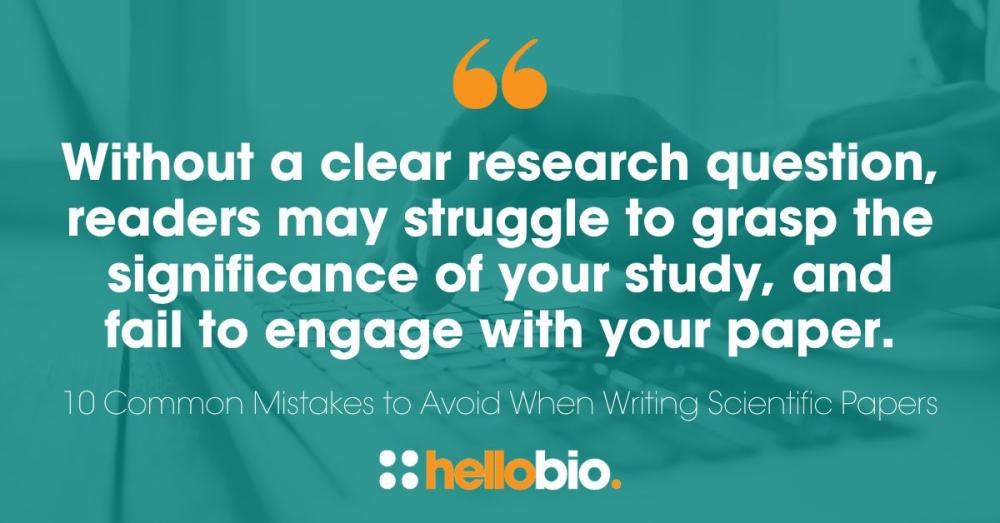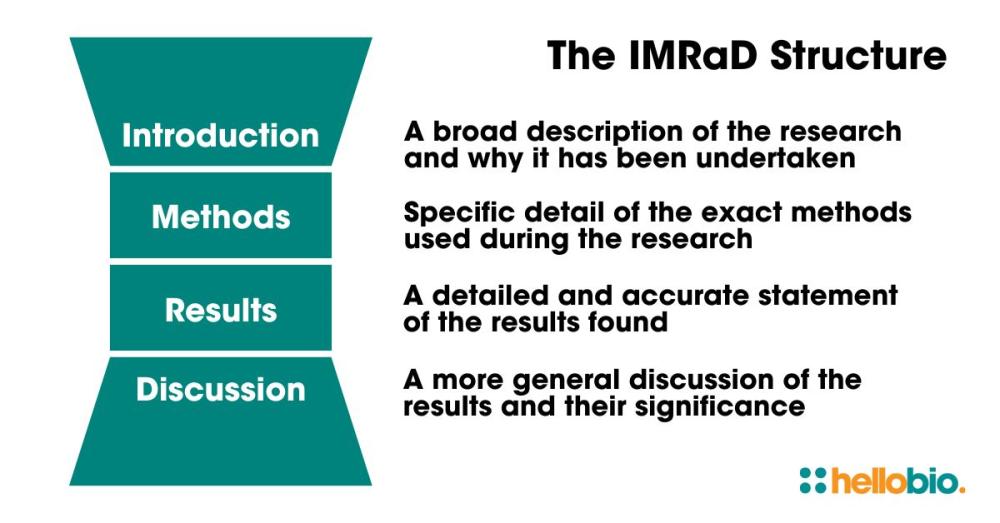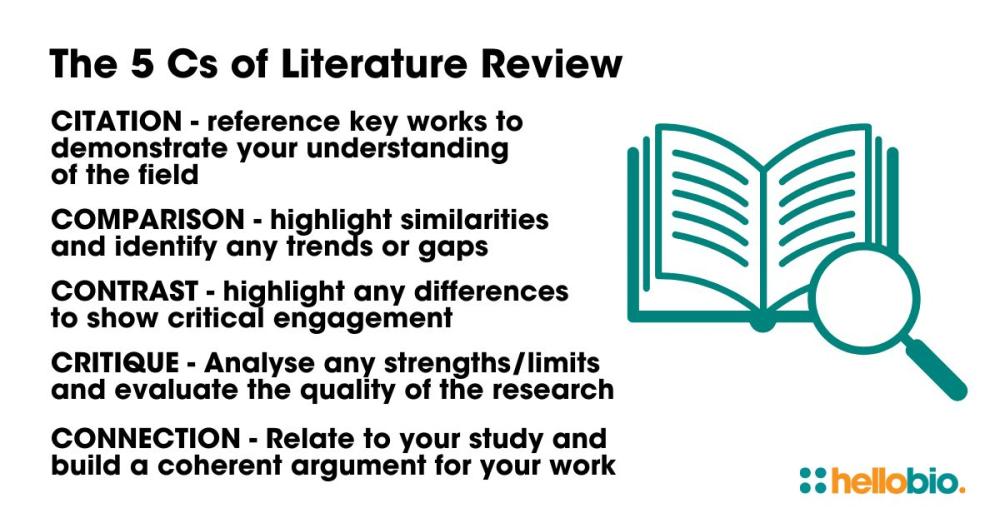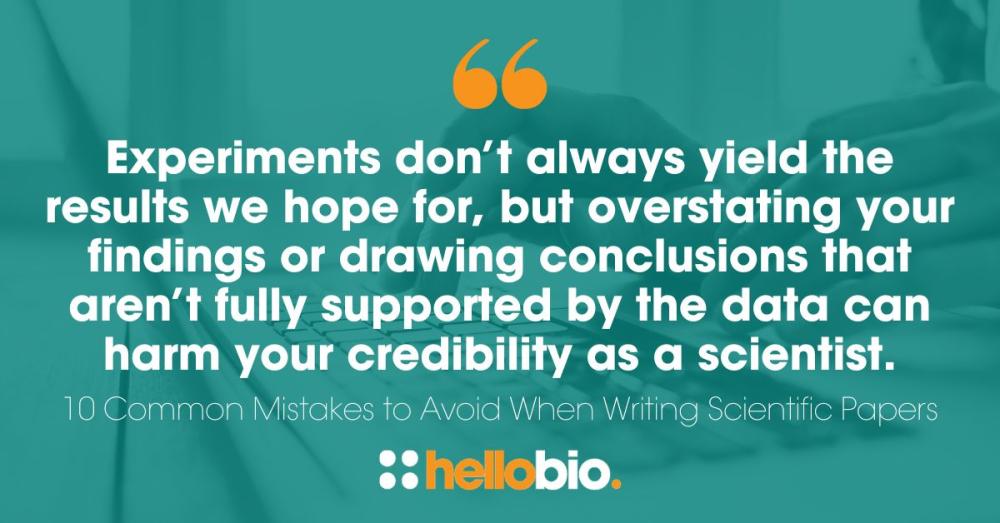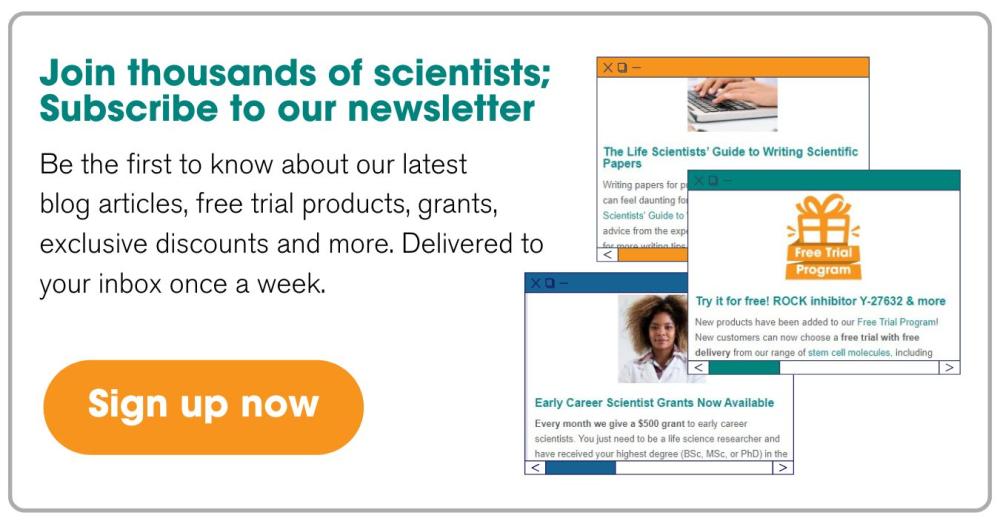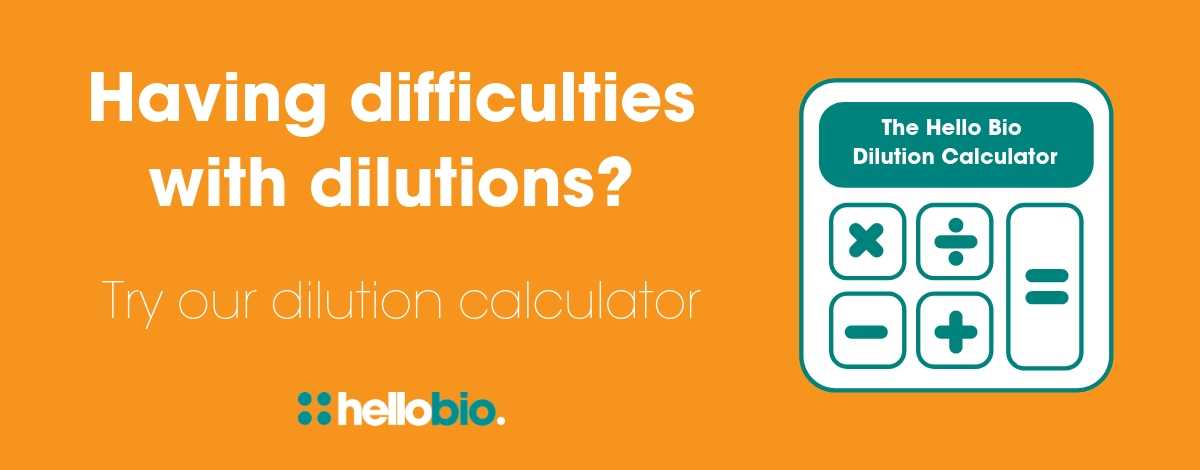10 Common Mistakes to Avoid When Writing Scientific Papers
For life science researchers in the early stages of their careers, learning how to write high-quality scientific papers is an essential skill to master. Getting your first paper published in a science journal is a career milestone, and getting work published regularly will be important if you have aspirations to climb the STEM career ladder. Tenure decisions, grant applications, and job offers often depend on a scientist’s publication record.
A scientific paper is also one of the most effective ways for researchers to share their findings with the broader science community as well as the wider public, and a well-written paper will ensure that your research is both clearly communicated and easily understood.
There are a number of common mistakes that crop up time and again when editors proofread scientific papers. From lack of detail in literature reviews to overloaded visuals, poor structure to too much technical jargon, there’s lots to consider if you want to give your research work the strongest possible platform for publication. We’ve picked out 10 common mistakes that scientists often make when writing a research paper, and offer top tips to help you avoid these errors and maximise your chances of success!
1. Not stating the research question clearly
One of the most common mistakes scientists make at the very start of their papers is failing to clearly define the research question. The introduction to your paper should include a precise outline of the problem that your research is addressing, and why it matters, both to you and the research community. Without a clear research question, readers may struggle to grasp the significance of your study, and fail to engage with your paper. Clarity is essential in all aspects of science writing, so be sure to use language that leaves no possibility of misinterpretation or confusion.
TOP TIP: Start the introduction to your paper by framing the broader context, then narrow the detail down to your specific research question. Using phrases like “This study aims to address…” will help to signal your objective to the reader.
2. A badly written abstract
The abstract within your paper should provide a concise summary of its contents and will often determine whether or not the reader will continue to read the entire manuscript. Because it is the first (and sometimes only) part of your paper that most people will read, it needs to be engaging and must provide a coherent outline of the research problem, methods, findings, conclusions, and the overall importance of the work. A poorly written abstract can discourage readers from engaging with your work, so putting a little extra time into crafting this section of your paper can ensure that your work reaches a wider audience.
TOP TIP: A great way to ensure nothing is missed from your abstract is to save the writing of it until last! Once your entire manuscript is finished you’ll be able to ensure that the abstract is a complete summary of the entire paper. For advice on including keywords in your abstract, check out these writing tips from Dr Bronwen Martin of the University of Antwerp...
3. Lack of structure and flow
A well-structured scientific paper should follow a logical flow that guides the reader through your research journey. If your paper lacks structure and includes disjointed sections, abrupt transitions, or missing links between ideas, this can confuse the reader and take away from the impact of your work. A paper with good flow ensures that your most important results are highlighted and emphasized at the right points in the text. If your key findings are buried in a poorly structured paper, readers may overlook them entirely.
TOP TIP: A popular and useful format to use is the IMRaD structure which sees a paper arranged into four main sections: Introduction, Methods, Results, and Discussion. This structure allows for both broader discussions of the research question and findings, as well as more specific and focused detail with regard to the methods and results.
4. Overuse of jargon
While the use of technical language is absolutely necessary in scientific writing, excessive use of jargon can sometimes alienate readers who are unfamiliar with those types of specialist terms. If science communication skills are something you’re particularly interested in developing further, it’s good practice to ensure that everything you write is not only accessible to specialists in the field, but also to journalists, students, and the general public too.
TOP TIP: Use technical terms sparingly and ensure you define and explain any specialized language in more simple terms. Aim for clarity and simplicity without sacrificing the scientific accuracy of the work.
5. An incomplete literature review
A weak or incomplete literature review can undermine your credibility as a researcher. A good literature review should provide context for your research, demonstrate your understanding of existing knowledge, and justify the novelty and importance of your study. Failing to identify and understand the research that already exists around your chosen topic leaves you open to potentially missing opportunities and even duplicating work that’s already been done by others.
TOP TIP: Conduct a thorough literature search and ensure your references are 100% up to date. Follow the 5 Cs of literature review - citation, comparison, contrast, critique and connection.
6. Insufficient method detail
The purpose of the ‘Methods’ section within a scientific paper is to provide enough detail for another researcher to accurately replicate the research being described. A common mistake made by many early career researchers is to assume that some method details are too ‘obvious’ to mention. However, leaving out even the smallest detail is a risk, and can be detrimental to the quality and reliability of your work.
TOP TIP: Include specific information about the exact design of your experiment, sample sizes, data collection techniques, and analysis methods. If you’ve used a published protocol, be sure to cite it, but also describe any modifications you’ve made to it.
7. Misinterpreting results
It’s important to remain objective when interpreting your research results. While experiments don’t always yield the results we are hoping for, overstating your findings or drawing conclusions that aren’t fully supported by the data can harm your credibility as a scientist. Always remember that negative results can be just as useful to the research world as the more exciting findings and discoveries. Unexpectedly negative results can inform future studies by helping other scientists to adapt their work accordingly.
TOP TIP: Be cautious with the language you use when discussing your results. Avoid using phrases like “prove” or “demonstrate” and instead use “suggest” or “indicate.” This will clearly distinguish between your results and your interpretations, giving more credibility to your work and to you as a researcher.
8. Ignoring journal guidelines
If you’re writing a paper for submission to a specific journal, it’s essential to check their guidelines before you start to write. Each journal will have their own specific requirements for manuscript preparation, which could include formatting, word count, and referencing style. Ignoring these guidelines or failing to fulfil the exact submission requirements can often mean your paper will be rejected before it’s even been read!
TOP TIP: Once you’ve identified the journal you want to submit to, take a closer look at some of the papers they’ve published previously to get a feel for what’s expected of you as an author and editor. Use these examples as a point of reference, and tailor your manuscript accordingly to match their style.
Take a look at The Life Scientists' Guide to Getting Published for more advice on preparing your paper for submission to journals: https://hellobio.com/blog/the-life-scientists-guide-to-getting-published.html
9. Overloading figures and tables with too much information
Figures and tables are powerful tools for communicating your data and results, but overloading them with too much information can be overwhelming for readers. Well-designed, simple visuals make it easier for readers to interpret your findings and draw conclusions. The goal should be to guide readers through your results, so overloading figures and visuals can reduce the impact of your findings by hiding them in a clutter of irrelevant data.
TOP TIP: Focus on one main message per figure, then use additional figures or supplementary materials for more detailed data. Also, remember that you don’t have to fill every single space on the page! Using white or blank space effectively can help to guide the reader’s eye to the most important parts of your figure.
10. Failing to proofread thoroughly
It seems obvious, but you’d be amazed how many scientists fail to proofread or double-check their work properly before submitting a paper. A piece of work that is packed with spelling errors, grammar mistakes, or inconsistencies will reflect poorly on your professionalism, and even the most minor of errors can distract readers and reviewers from fully engaging with and understanding your scientific message.
TOP TIP: Consider using a proofreading tool or hiring a professional editor to look through your work before submitting to a journal for review. Ask a colleague or mentor to review your paper and provide feedback before submission. Don’t take corrections or criticism personally! It’s important that anyone reviewing your work is honest and constructive with their feedback in order to help you produce your best possible work.
___________________________________________
More science writing tips from Hello Bio
For more advice on writing scientific papers and getting your research work published, take a look at these other great resources on the Hello Bio blog:
- Scientific Papers: Tips for More Productive Writing
- How do you get started in science writing?
- Five Essential Tips for Writing Scientific Papers
- The Life Scientists' Guide to Writing Scientific Papers
- 6 Top Science Writing Tips from the Experts
- Sailing Through Your PhD Thesis: Writing Tips
- Beyond the Manuscript: Maximizing Impact through Diverse Writing Outlets
- The Art of Writing Scientific Papers - Resources for Researchers
________________________________
If you enjoyed this article, why not check out the other resources available on our blog. We are passionate about supporting life scientists including early career life scientists and PhD students - with really low-priced reagents, antibodies and biochemicals, early career scientist grants, and resources to help with both personal and professional development. We know how tough it is - so we hope you find these helpful!
More General Support for Life Scientists
For advice on wellbeing, dissertations, presenting at conferences, wellbeing, PhD support, networking and lots more, we have a huge range of articles to help - just click below:
Save up to 50% on our high purity reagents...
When you get to the stage of planning your experiments, don't forget that we offer a range of low-cost, high-purity agonists, antagonists, inhibitors, activators, antibodies and fluorescent tools (yes - they really are around half the price of other suppliers!) You can use our Quick Multi-Search Tool to search for lots of products in one go, and the range includes:
- Enzyme inhibitors and activators
- Chemogenetic ligands
- Ion channel modulators
- GPCR & ionotropic receptor ligands
- Cell biology reagents & biochemicals
Technical resources
Try our Molarity Calculator: a quick and easy way to calculate the mass, volume or concentration required for making a solution.
Try our Dilution Calculator: an easy way to work out how to dilute stock solutions of known concentrations
We also offer a comprehensive range of technical resources including antibody protocols and methods, product guides and mini-reviews:
And finally, don't forget to check back in with our blog regularly for our latest articles. If there’s something you’d love to contribute to the community, whether that’s an interview or article, drop us a line at hello@hellobio.com
---






